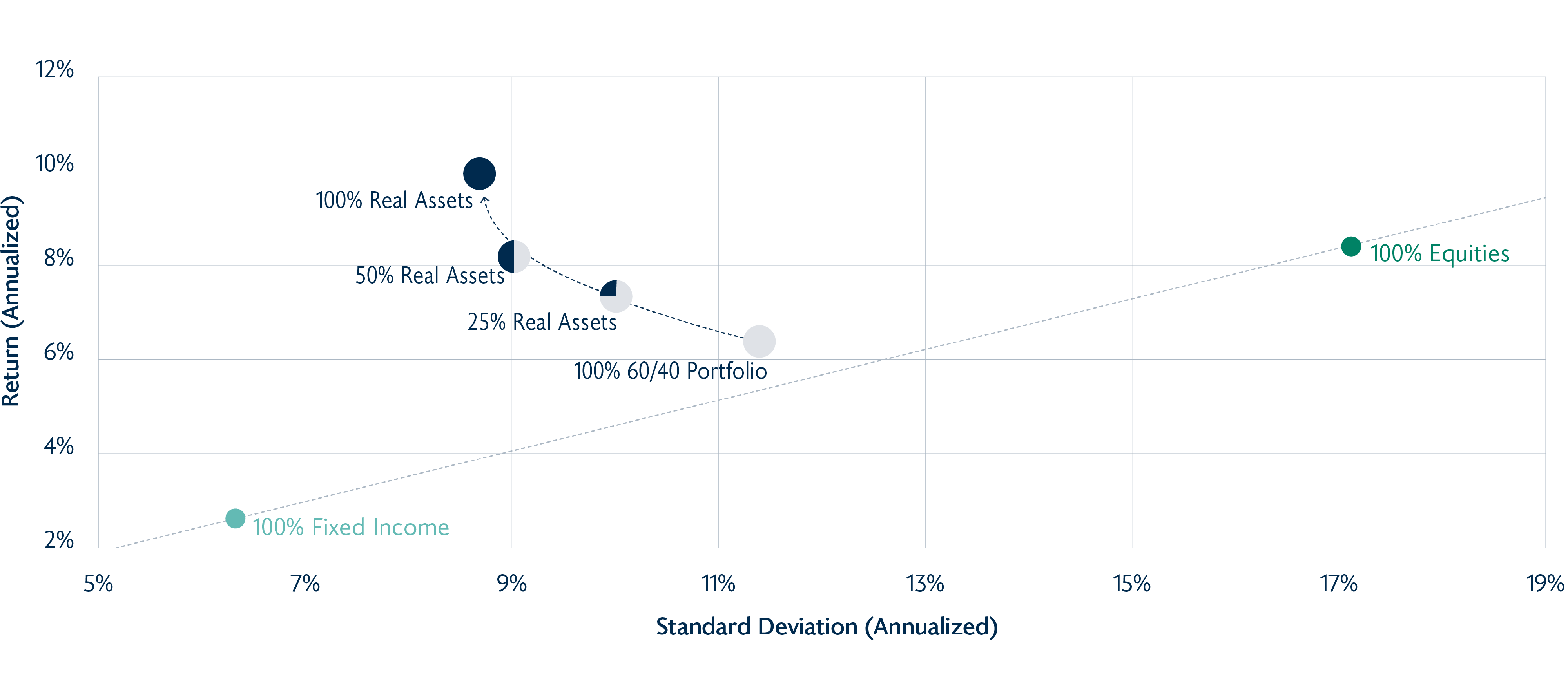Market
Memos from Howard Marks: Cockroaches in the Coal MineWe believe adding real assets to a traditional portfolio may reduce volatility and increase returns.
Adding real assets to a traditional 60% equity/40% fixed-income portfolio may reduce volatility and increase returns.

Past performance is not indicative of future results.
Source: Bloomberg, Cambridge Associates, Brookfield Public Securities Group LLC., for the period January 1, 2003, through to September 30, 2022. Equities reflect the MSCI World Index. Fixed Income reflects the Bloomberg Barclays Global Aggregate Index. A 60/40 Portfolio reflects a blend comprised of 60% Equities and 40% Fixed Income. Real Assets reflects a custom blend consisting of 50% Cambridge Real Estate Index and 50% Cambridge Infrastructure Index.
We believe that adding real assets to a traditional portfolio of stocks and bonds offers diversification benefits that may serve to reduce volatility and increase returns. We illustrate this view with an analysis that compares the historical returns and volatility of portfolios with varying allocation mixes of global equities, global fixed income and a blend of private and public real assets. The chart above shows how adding real assets to a traditional 60 equity/40 fixed-income portfolio may increase a portfolio’s return potential while decreasing its risk.
Important Disclosures
Forward-Looking Statements
Information herein contains, includes or is based upon forward-looking statements within the meaning of the federal securities laws, specifically Section 21E of the Securities Exchange Act of 1934, as amended, and Canadian securities laws. Forward-looking statements include all statements, other than statements of historical fact, that address future activities, events or developments, including, without limitation, business or investment strategy or measures to implement strategy, competitive strengths, goals, expansion and growth of our business, plans, prospects and references to our future success. You can identify these statements by the fact that they do not relate strictly to historical or current facts. Words such as “anticipate,” “estimate,” “expect,” “project,” “intend,” “plan,” “believe” and other similar words are intended to identify these forward-looking statements. Forward-looking statements can be affected by inaccurate assumptions or by known or unknown risks and uncertainties. Many such factors will be important in determining our actual future results or outcomes. Consequently, no forward-looking statement can be guaranteed. Our actual results or outcomes may vary materially. Given these uncertainties, you should not place undue reliance on these forward-looking statements.
Index Provider Disclosures
Brookfield Public Securities Group LLC does not own or participate in the construction or day-to-day management of the indices referenced in this document. The index information provided is for your information only and does not imply or predict that a Brookfield Public Securities Group LLC product will achieve similar results. This information is subject to change without notice. The Indices referenced in this document do not reflect any fees, expenses, sales charges, or taxes. It is not possible to invest directly in an index. The index sponsors permit use of their indices and related data on an "As Is" basis, makes no warranties regarding same, does not guarantee the suitability, quality, accuracy, timeliness, and/ or completeness of their index or any data included in, related to, or derived therefrom, assumes no liability in connection with the use of the foregoing. The index sponsors have no liability for any direct, indirect, special, incidental, punitive, consequential, or other damages (including loss profits). The index sponsors do not sponsor, endorse, or recommend Brookfield Public Securities Group LLC or any of its products or services.
Index Definitions
The MSCI World Index is a free float-adjusted market capitalization-weighted index that is designed to measure the equity market performance of developed markets.
The Bloomberg Barclays Global Aggregate Index is a market capitalization-weighted index comprising globally traded investment-grade bonds. The index includes government securities, mortgage-backed securities, asset-backed securities and corporate securities to simulate the universe of bonds in the market. The maturities of the bonds in the index are more than one year.
The Cambridge Associates Real Estate Index is an end-to-end calculation based on data compiled from real estate funds (including opportunistic and value-added real estate funds), including fully liquidated partnerships, formed beginning in 1986.
The Cambridge Associates Infrastructure Index represents a horizon calculation based on data compiled from infrastructure funds, including fully liquidated partnerships, formed beginning in 1993.
Definitions of Terms
Annualized Return is periodic returns rescaled to a period of one year.
Annualized Volatility is periodic volatility rescaled to a period of one year.